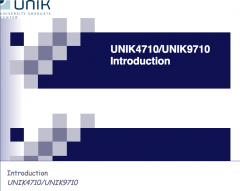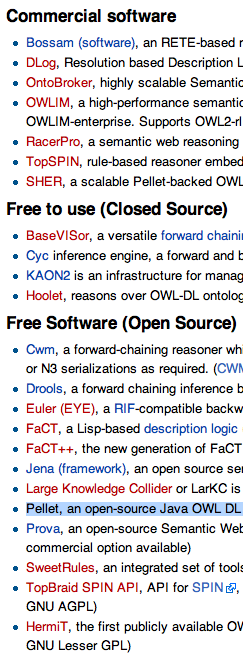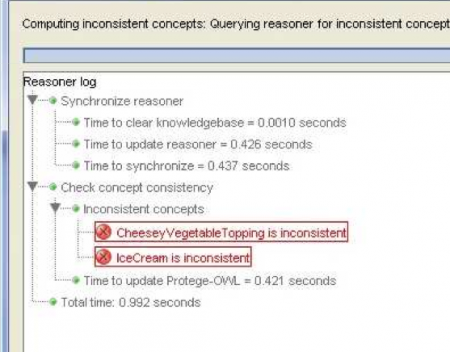Comparison of Pellets, FaCT and HermiT
| Wiki for ITS | ||||||
|---|---|---|---|---|---|---|
|
Comparison of Pellets, FaCT and HermiT
| Course | UNIK4710, UNIK9710 |
|---|---|
| Title | Comparison of Pellets, FaCT and HermiT |
| Lecture date | 2013/04/12 |
| presented | by Josef Noll |
| Objective | This lecture provides an introductory to the comparison of selected reasoners |
| Learning outcomes | Having joined this lecture, you will
|
| Pensum (read before) | |
| References (further info) | * http://answers.semanticweb.com/questions/12112/what-are-the-differences-among-pellet-hermit-and-fact |
| Keywords | Reasoning, FaCT, Pellets, HermiT |
this page was created by Special:FormEdit/Lecture, and can be edited by Special:FormEdit/Lecture/Comparison of Pellets, FaCT and HermiT.
Note: streaming starts only at 11:00h
Tasks
- See Lecture notes Media:UNIK4710-L11-v13.pdf
We move to Protege 4.2, well knowing that this version has challenges, e.g. SWRL creation, relation of object properties.
Please prepare
- more complex rules using SWRL
- a presentation of your envisaged final application
Through these excercises you will be able to evaluation what can or can't be done in Protege 4.2
Addressed challenges
- time stamp of information
- number (real, double) comparison
- object properties comparison
Lecture notes
- Reasoner Comparison (by Josef): Comparison_of_Pellets,_FaCT_and_HermiT|Comparison of HermiT, Fact++ and Pellets
- internal versus external reasoning
Lecture notes 2013
Presentation
- Title
- Reasoning
- Author
- Josef Noll
- Footer
- Comparison of Pellets, FaCT and HermiT
- Subfooter
- UNIK4710/UNIK9710
⌘ Reasoner
The goal of a reasoner is to derive information from a knowledge base. The reasoner is involved through an inference engine, e.g. the Jess engine involves a Pellet reasoner.
W3 (World wide web consortium) has published a list of reasoners [1]
⌘ Examples of reasoners
FaCT++ is an open-source tableaux-based OWL 2 DL reasoner. It is implemented in C++ and shows exceptional performance on expressive ontologies.
- Fully conformant with OWL DL except for keys and some datatypes
- new developed based on ideas from FaCT
HermiT can determine whether or not the input ontology is consistent, identify subsumption relationships between classes, and much more.
- Based on a novel hypertableau algorithm,
- efficient reasoning
- Fully conformant
Pellet is an open-source Java OWL DL reasoner
- developed by
- tableau based decision procedure
Jena is an open source framework, including reasoning modules
⌘ Terminology
Assertional Box (Abox)
- contains assertions about individuals,i.e. OWL facts such as type, property-value...
- Realizing the ABox, i.e. computing the most specific concept(s) that each individual is an instance of.
- Example: all people being students
Terminological Box (Tbox)
- contains axioms about classes, i.e.OWL axioms such as subclass, equivalent class...
- Example: 'Class:Pizza has subclass:American Pizza'
Knowledge Base (KB):
- A combination of an ABox and a TBox, i.e.a complete OWL ontology.
major use cases:
- Frequent ABox changes (situation classification) and
- rare ABox changes (social networks).
⌘ Reasoner comparison
Good intro from Bock et al.[2]
- open source versus other licenses
- language, portability
- logic support (e.g. OWL DL)
- performance:
- load time
- query time
- addressing: Language complexity, and size of ontology
Conclusions from Bock et al.
- reasoners that employ a simple rule engine scale very well for large ABoxes, but are in principle very limited to lightweight language fragments,
- classical tableau reasoners scale well for complex TBox reasoning tasks, but are limited with respect to their support for large ABoxes,
- the reasoning techniques based on reduction to disjunctive datalog as implemented in KAON2 scale well for large ABoxes, while at the same time they support are rich language fragment.
⌘ Pellet
based on a presentation by Susana: Media:Pellet_Reasoner.pdf
- Pellet is an open-source Java based OWL DL reasoner, see Pellets-based_reasoning
- can be used with Jena and OWL API libraries.
Features:
- Consistency checking: ensures that an ontology does not contain any contradictory facts.
- Concept satisfiability: checks if it is possible for a class to have any instances.
- Classification: computes the subclass relations between every named class to create the complete class hierarchy.
- Realization: computes the direct types for each of the individuals.
⌘ Main modules
- Parsing and Loading: Pellet include different submodules that can load ontologies from different representations (Jena, WonderWeb..).
- Tableaux Reasoner: has the functionality of checking the consistency of an ontology by constructing a graph from the Abox.
- class relations: subsumption, satisfiability, and classification
- Datatype Reasoner: is responsible for checking if the intersection of datatypes is consistent or not.
- Knowledge Base Interface: makes decisions to check the consistency of the ABox, when to classify all the concepts or when to realize all the individuals and answer queries.
- ABox Query Engine for retrieval, conjunctive query answering
⌘ Reasoner outcome
Reasoners detect inconsistent ontologies but the diagnosis and resolution of the bug is not supported at all.
- Pellet contains two debugging services that help explain why the inconsistency occurs:
- service clash detection is used to pinpoint the root contradiction or clash in the completion graph;
- axiom tracing is used to extract the relevant source axioms from the ontology responsible for the clash.
⌘ Discussion
- internal consistency check versus external rules
- implementation of external rules
- Example: Jess Engine in Protege 3.x
- Example: Rule tab in Protege 4.x
- Rules are not limited to SWRL define your own "custom built-ins"
- reference: Custom SWRL
References
- ↑ http://www.w3.org/2007/OWL/wiki/Implementations
- ↑ Jürgen Bock, Peter Haase, Qiu Ji, Raphael Volz, "Benchmarking OWL Reasoners", [1]


